A cluttered kitchen doesn't just look messy—it slows everything down. You spend more time looking for ingredients, stacking dishes, and trying to remember where that one thing was stored. Whether you're cooking dinner for the family or grabbing a quick snack, disorganized cabinets can make the process frustrating. But the good news is, you don't need a new kitchen. With a few well-planned strategies, your existing cabinets can serve you far more efficiently.
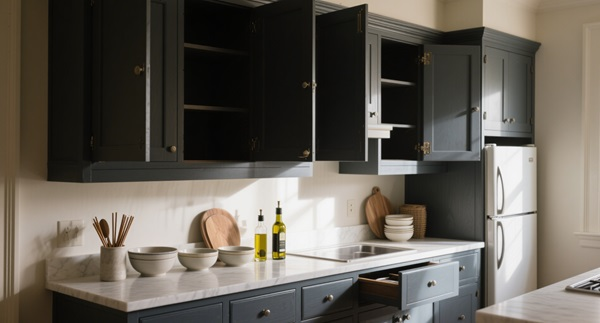
Before any organizing begins, everything must come out. That includes all plates, containers, snacks, pans, and those random tools you forgot were even there. Spreading the items out on the countertop or kitchen table gives you a full picture of what you're working with. It also creates a rare opportunity to see how much of what you own is actually being used.
With cabinets empty, grab a soft cloth and a gentle cleaner. A mix of warm water and dish soap works for most surfaces. If you prefer something more natural, white vinegar and water can remove grease and odors. Pay attention to the corners and shelf edges where crumbs and dust tend to collect. If your shelves use liners, check whether they need replacing.
Next, examine the cabinet layout itself. Adjustable shelves are often underutilized. A few tweaks to shelf height can make space for taller containers or allow stacking plates more comfortably. Don't skip this chance to improve the internal layout before items go back in.
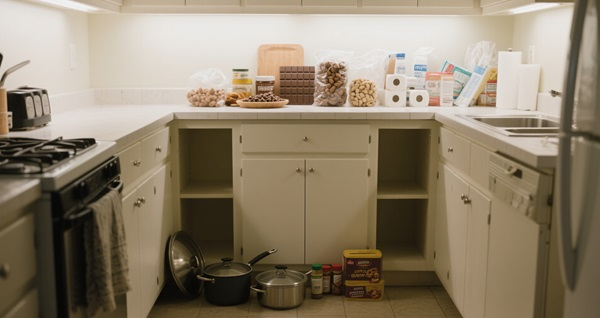
Now that everything is out in the open, begin sorting by type. Group baking ingredients together, cookware in one area, canned goods in another, and so on. The idea is to create logical categories based on how the items are used. As you go, you'll probably discover expired food, duplicate utensils, or random gadgets that haven't seen the light of day in years.
This is the moment for honest evaluation. Do you really need three can openers? Is that old immersion blender worth the space it takes up? If something hasn't been used in six months or longer—and isn't seasonal—it's worth considering whether it should stay. For items you're unsure about, create a “maybe” box. If you don't reach for them in the next two months, you'll know the answer.
If possible, separate daily-use items from occasional-use ones. This helps guide where each item should eventually be stored for maximum convenience.
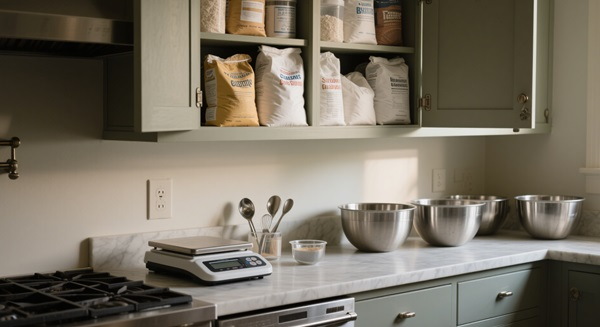
Your kitchen functions better when each area has a dedicated role. Just like a well-organized office has a space for documents, supplies, and tech gear, your kitchen can be divided into work zones. These zones reflect how and when you use items.
Start with a prep zone. This should be near the sink or cutting area and hold cutting boards, knives, mixing bowls, and measuring cups. A cooking zone, close to the stove, can hold pots, pans, spatulas, and cooking oils. Baking zones include flour, sugar, baking soda, measuring tools, and mixing bowls. Breakfast items like cereal, spreads, and coffee should live together near the toaster or coffee machine.
Zones work well for busy households because they reduce overlap. One person can prep lunch while another makes coffee, each working in their own space. Over time, this setup becomes second nature and prevents messes from piling up.
If you have kids, a snack zone with healthy options in reachable drawers or baskets gives them independence. Just make sure fragile or heavy items are kept safely out of reach.
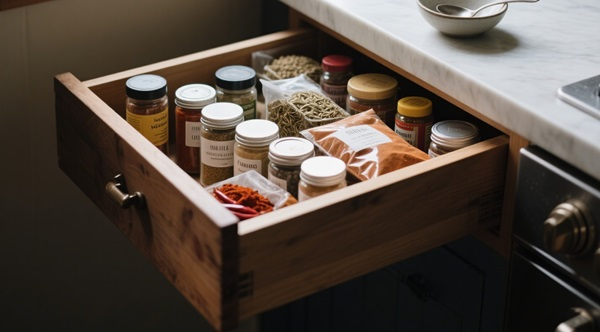
You don't always need more cabinets—just smarter ways to use what you have. Interior storage tools can double or triple the efficiency of a single cabinet. The right organizer creates clarity instead of chaos.
Start with the basics: shelf risers, Lazy Susans, and drawer inserts. Shelf risers are especially helpful for stacking plates, cups, or canned goods without hiding anything behind. A Lazy Susan makes deep corner cabinets usable again. Drawer dividers can turn junk drawers into organized compartments for utensils, scissors, or small gadgets.
If you store spices, try a tiered shelf or a pull-out spice drawer. Seeing every label at once eliminates the need to dig. For pots and pans, pan racks and vertical dividers reduce the dreaded tower of cookware that collapses when you grab one item.
Inside cabinet doors, hooks or baskets offer space for oven mitts, foil rolls, or dish gloves. These additions don't need screws—many stick on or hang over the door. They create storage in places often ignored.
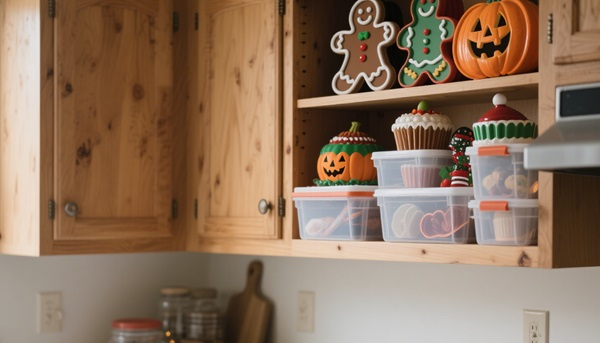
Once your categories and zones are clear, think about frequency. This is a key organizing principle: store what you use most at eye level and within arm's reach.
Daily items like plates, mugs, or food containers belong in easy-to-access spots. Reserve higher or lower shelves for seasonal bakeware, party platters, or backup supplies. For example, if you only use a slow cooker occasionally, it doesn't need to take up prime cabinet real estate.
Base cabinets tend to be the least convenient, so save those for bulky or seldom-used items. To improve their accessibility, add pull-out drawers or baskets. These make it easier to reach the back without unloading everything in front.
This rule also applies to pantry goods. Group your frequently used ingredients at the front and place surplus or duplicates in back. That way you always see what's available and avoid buying what you already own.
Visibility is a powerful organizing tool. The more you can see, the more likely you are to use what you have. Transparent bins and containers make it easy to scan contents without opening every lid. Clear acrylic, glass jars, or wire baskets all work well, depending on what you're storing.
Labeling is especially helpful for dry goods and snack zones. It's not about perfection—just clarity. Labels guide other members of your household and help keep the system intact.
Avoid stacking items that block your view or require shifting others to get to them. If you must stack, use open bins that slide or nest efficiently. In drawers, use shallow containers or bamboo trays that show everything at once.
Also consider decanting bulk goods into smaller, everyday-use containers. This saves space and improves flow, especially when storage depth is limited.
No system will stay perfect on its own. The good news is, it doesn't take much to maintain an organized kitchen once the heavy lifting is done.
Pick one day each week—maybe Sunday evening—to do a five-minute reset. Return items to their proper spots, toss out leftovers or expired foods, and wipe down visible surfaces. Over time, these check-ins become routine and prevent clutter from creeping back in.
Encourage family members to follow the system. If everyone knows where the cereal goes or where to find kitchen shears, the system reinforces itself. You can even post a quick “zone guide” on the fridge if needed.
When something feels off—maybe a drawer gets too crowded or snacks pile up—it's okay to adjust. Organization isn't static. Your kitchen evolves with your habits, and your storage system should evolve too.
Mistakes to Avoid When Organizing Cabinets
Even with the best intentions, some common mistakes can set you back. The first is prioritizing appearance over function. Matching bins and labels are nice, but if they don't make your daily routine easier, they're not worth the effort.
Another issue is using storage tools that don't actually fit the space. Measure carefully before buying organizers. An over-the-door rack that blocks cabinet closure, or a shelf that sags under weight, creates more frustration than convenience.
It's also a mistake to overstuff every shelf. Just because an item fits doesn't mean it belongs there. Leave space for air and movement. A less crowded cabinet is more inviting to use.
Finally, avoid temporary fixes like stuffing plastic bags or cords behind items “just for now.” These quick fixes tend to become permanent clutter.
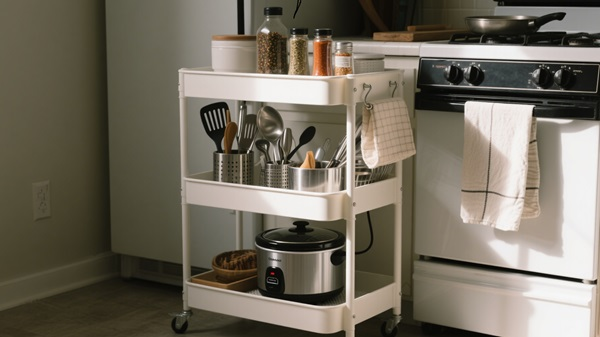
Sometimes, even after purging and rearranging, you still don't have room. Before assuming you need a remodel, look beyond the cabinets.
Vertical wall space is often underutilized. Pegboards, floating shelves, or mounted rails with hooks can hold utensils, pans, or mugs. The inside of pantry doors can hold spice racks or cleaning supplies. Magnetic strips for knives or jars save drawer space.
Mobile storage like rolling carts or freestanding shelving can also help. These provide flexibility and can be tucked into unused corners.
But if you've tried all the tricks and still find yourself short on space, the issue may be with your cabinet layout or capacity. That's when it makes sense to think about upgrading your cabinetry to something better suited to your cooking habits and storage needs.
BFP's kitchen cabinets offer a wide variety of inner dividers and kitchen accessories designed to enhance everyday storage. The system is both flexible and practical, making it easier to keep your kitchen organized and visually tidy.
A well-organized kitchen isn't just about looking tidy—it's about creating a space that works for you. When every item has a place, you cook faster, clean easier, and waste less. By taking the time to reset your cabinets with purpose and structure, you make your kitchen a more functional and enjoyable space.
If you're thinking about reconfiguring or upgrading your cabinetry to better support your daily routines, BFP Cabinetry offers a wide selection of kitchen cabinets designed to combine beauty with utility. Their cabinet solutions support smarter storage and help turn even small kitchens into efficient, clutter-free zones.
Contact us at sales7@bfpglobal.com.
We employ cookies to analyze website traffic and enhance your browsing experience. Data securely aggregated, privacy protected. See Privacy Policy for details.